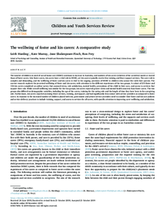Displaying 621 - 630 of 2214
This chapter from the book Education in Out-of-Home Care outlines the skills that are necessary for a successful start to formal schooling for children placed into out-of-home care (OHC).
This chapter from the book Education in Out-of-Home Care reviews the available research on issues related to early childhood education and care (ECEC) for children in foster care in Australia and reports findings on the ECEC experiences of 60 children aged 3 to 5 years from the Australian Early Childhood in Foster and Kinship Care study.
This book draws together for the first time some of the most important international policy practice and research relating to education in out-of-home care.
This chapter from the book Education in Out-of-Home Care examines how far education and the school context meet the educational needs of out-of-home care children in Hong Kong from the perspective of inclusive education.
The current research explores the perceived wellbeing of foster and kin carers, with attention to the different experiences of the two groups.
This Chapter from the book Education in Out-of-Home Care reviews research and promising programs in the U.S. affecting the educational success of children in foster care.
This chapter from the book Education in Out-of-Home Care examines as case studies the Australian media coverage of final secondary results, juxtaposed with the experiences of several care-leavers currently attending a regional university, as gleaned from in-depth interviews and enrolment data-analysis. These accounts consistently affirm an array of systemic and cultural obstacles to the successful pursuit of their education.
This Chapter from Education in Out-of-Home Care illustrates that increased resourcing is needed to facilitate the achievement of improved education outcomes for Australian primary school children in out-of-home care (OHC).
In this chapter from the book Education in Out-of-Home Care the authors highlight ongoing legislative and policy challenges related to postsecondary education for care leavers.
This chapter from the book Education in Out-of-Home Care presents findings from a study of the educational progress of Out of Home Care (OHC) children in England.

